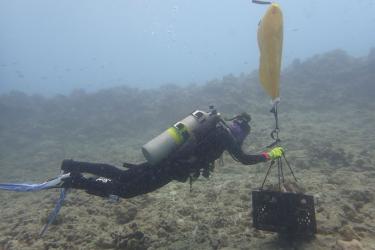Scientists in the Pacific Islands region published new research that can help predict catch rates in the Hawaiʻi longline fishery. Drs. Phoebe Woodworth-Jefcoats and Johanna Wren found that information about phytoplankton (microscopic algae) can be used to forecast catch rates for bigeye tuna. They used the size of phytoplankton to forecast catch rates for up to 4 years. This information could help advance ecosystem-based fisheries management in the Pacific Islands region.
Woodworth-Jefcoats and Wren hypothesize that the size of phytoplankton is an indicator of the quality of food for larval and juvenile bigeye tuna. While bigeye tuna don’t actually eat phytoplankton, they do eat zooplankton that eat phytoplankton. Zooplankton are tiny animals that drift with the ocean currents and are prey to many oceanic species. When there is more large phytoplankton, there is likely more large zooplankton and more high-quality food for young bigeye tuna. And when young bigeye tuna have better food, more of them survive to reach adulthood. These fish are then available for capture by the Hawaiʻi fishery.
Scientists can estimate phytoplankton size from satellite measurements of sea surface chlorophyll and temperature. Woodworth-Jefcoats and Wren used satellite measurements from 1998 to 2017. Because the majority of bigeye tuna caught by the Hawaiʻi longline fleet are about 4 years old, they can use the satellite data to forecast catch rates for 2002–2021. They compared these forecasts of catch and weight, based also on fishing effort, to fishery data from 2002 to 2018. The ability to forecast the weight of the catch is particularly encouraging because this fishery is managed on an annual tonnage quota. The scientists will continue updating their forecast and are exploring ways to improve it.
This information could help the Hawaiʻi longline fishery plan for the future. Scientists may also use this information to improve stock assessments of bigeye tuna and other species caught by the fishery. Such improvements could be particularly useful for bigeye tuna because research has identified overfishing of some Pacific bigeye tuna stocks in recent years. Knowing in advance how fish populations may fluctuate could help managers and the fishing industry adjust quotas or catch to changing environmental conditions, potentially reducing the risk of overfishing.





